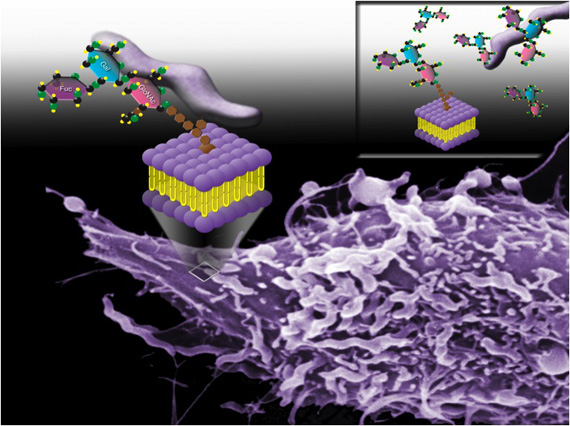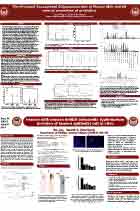| |
Did you know that in the United States the average person consumes about 25 gallons
of cows´ milk per year?
Yet that doesn´t even come close to the nearly 65 gallons recommended by the United States Department of Agriculture! And these numbers only refer to cows´ milk. In fact, all mammals, including humans, produce milk to feed their offspring. The composition of maternal milk varies from species to species depending on the needs of the offspring. For example, human milk is higher in fat and the sugar lactose than either cow or goat milk, but much lower in protein.
Human milk is also unique in its composition of
complex carbohydrates molecules called oligosaccharides or glycans. Various glycans make up the third largest component in human milk. According to research by Dr. David Newburg and his colleagues at Boston College, these glycans play a key role in protecting infants from infectious diseases. Some of the diseases are caused by pathogens such as
Campylobacter jejuni,
Vibrio cholerae
(cholera) and
Escherichia coli (E. coli).
When Dr. Newburg began his career, glycans were thought to be just byproducts and waste in human milk. Dr. Newburg wasn´t so sure. The large amount of glycans in human milk means that human mothers spend about 10 percent of their energy on the production of glycans. For Dr. Newburg, those numbers were too high for just “byproducts.” He hypothesized that glycans might have an actual function in human milk, and he set out to find out what it might be.
Somewhat Unexpected Result
Dr. Newburg first isolated glycans from human milk and purified them so he could use them in experiments. Since he hypothesized that glycans in breastmilk prevent disease in infants, he decided to test the glycans on
pathogens
that cause diarrheal diseases, one of the leading causes of infant deaths worldwide.
Dr. Newburg began his experiments in cell cultures that consisted of a common strain of human intestinal cells that can be grown in the laboratory. He first incubated the experimental group of the intestinal cells with glycans, and then he challenged them with a variety of pathogens. Next he compared these results to two control groups: (i) untreated intestinal cells and (ii) intestinal cells treated only with the pathogen. He then monitored the growth of the cells to see if they were infected with the pathogen.
"To his surprise, Dr. Newburg found that the glycans inhibited almost every pathogen from infecting the cells in culture."
This was such an odd result that Dr. Newburg was convinced there was something wrong with his technique, and he spent many months trying to figure out what it was. Finally, he came to the conclusion that nothing was wrong with his technique. The glycans in human milk were not merely waste byproducts as had been previously thought. The truth was, they prevented many early childhood diseases.
He has since performed similar tests in mice and rats with the same positive results.
"What is a pathogen? A microbe such as a virus, bacterium, or fungus that causes a disease is called a pathogen. Pathogen comes from Greek roots meaning suffering and producer of. Not all bacteria and other microbes cause disease, so pathogen refers only to those that do."
How is this disease prevention possible? Imagine that the pathogen has little hooks all over it. These little hooks could latch onto
receptors
on the surface of cells in the baby’s gut (think Velcro®), causing disease. But the glycans work by binding to the pathogen itself, basically, using up all the little binding hooks. This prevents the pathogen from binding to receptors on the surface of cells in the gut. Binding to cell surface receptors is the first step in any infection, so preventing the binding protects the animal (baby) from disease. Glycans are present in human milk in all possible chemical structures, so together they protect against almost all types of disease, perhaps even some we don´t yet know about. In fact, Dr. Newburg found that specific glycans inhibit specific pathogens, and some glycans can inhibit multiple pathogens.
It would make sense, therefore, that the extent to which infants are protected depends on the composition of glycans in their mothers´ breast milk. To test this theory, Dr. Newburg and his collaborators studied 93 breastfeeding mother-infant pairs from birth to 2 years of age. Data on infant feeding and diarrhea were collected weekly. A sample of milk from mothers 1 to 5 weeks after birth was analyzed for oligosaccharide content. Dr. Newburg found that infants who developed diarrhea were consuming milk with significantly lower amounts of glycans compared to infants whose mother’s milk contained high amounts of glycans. If the mother had low levels of oligosaccharides, Dr. Newburg found that her child would be more likely to contract infection. He concluded that certain glycans were associated with less disease in young children.

The larger picture is Campylobacter jejuni binding to target cells, the blow up is the molecular structure of the receptor that binds to the campylobacter adhesin, and the insert is human milk 2'-fucosyllactose (a glycan) binding to the campylobacter adhesin such that the campylobacter can no longer bind to its target molecule on the cell surface receptor, and thereby 2'-fucosyllactose, the most common human milk oligosaccharide, inhibits campylobacter infection.
The next step for the researchers is to do a clinical trial to treat infants with diarrheal disease. In order to begin this next phase of research, he first needs to synthesize large amounts of specific glycans using manufacturing processes approved for use in humans. Dr. Newburg and his collaborators started a company called Glycosyn to make this possible, with the goal of manufacturing glycans on a large scale.
There are other applications of this work as well. Glycans are not just found in mother´s milk—they are also found in the brain, and glycan receptors are found on the surface of cancer cells. Dr. Purna Mukherjee, a researcher in Dr. Newburg’s laboratory, is investigating whether glycans isolated from human breastmilk can prevent tumor growth by preventing tumor cells from binding to the cell-surface glycan receptors of normal tissues.
Dr. David Newburg is a Professor of Biology at Boston College in Boston. His research focuses on how glycans in breastmilk prevent disease in infants and young children. In addition to his academic activities, Dr. Newburg helped start the Mother´s Milk Bank of New England to provide mothers who are unable to breastfeed with human breast milk for their babies. When not in the laboratory, Dr. Newburg enjoys all aspects of home renovation including woodworking, plumbing and electrical work. In his spare time he likes to run and row, and camp in the wild.
To Learn More:
- Morrow, A., et al. 2011. ¨Fucosyltransferase 2 Non-Secretor and Low Secretor Status Predicts Severe Outcomes in Premature Infants.¨ Journal of Pediatrics, 158: 745-751.
- 2. Newburg, D. et al. 2005. ¨Human Milk Glycans Protect Infants Against Enteric Pathogens.¨ Annual Review of Nutrition, 25: 37-58.
For More Information:
Diarrheal Diseases
- World Health Organization.
http://www.who.int/topics/diarrhoea/en/
- National Institutes of Health.
http://digestive.niddk.nih.gov/ddiseases/pubs/diarrhea/
Human Breastmilk
- American Pregnancy Association.
http://www.americanpregnancy.org/firstyearoflife/whatsinbreastmilk.html
- Mother´s Milk Bank of New England.
http://www.milkbankne.org/index.shtml
Rebecca Kranz with Andrea Gwosdow, PhD www.gwosdow.com
HOME | ABOUT | ARCHIVES | TEACHERS | LINKS | CONTACT
All content on this site is © Massachusetts
Society for Medical Research or others. Please read our copyright
statement — it is important. |
|
|
 From left to right are: Emily O'Day, Zhuoteng Yu, Gherman Wiederschain, Ceng Chen, David Newburg (in the back but the next face in the picture), Bo Liu, Alyssa Lee, Serena Leone, Purma Mukherjee, YingYing He, Monica Viveros, David Kling
To Go Deeper:

View Posters
Sign Up for our Monthly Announcement!
...or  subscribe to all of our stories! subscribe to all of our stories!

What A Year! is a project of the Massachusetts
Society for Medical Research.
|
|

